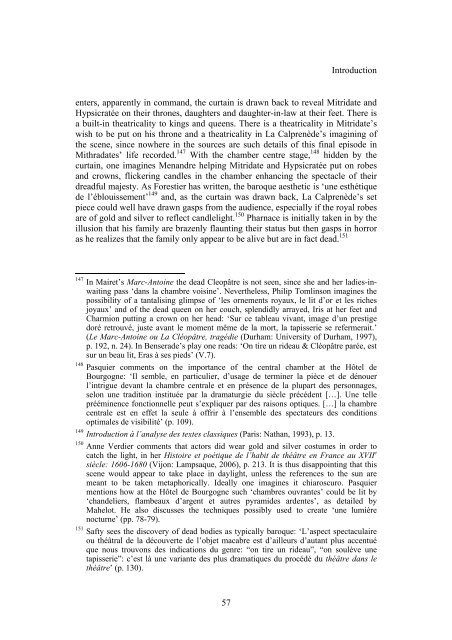LA MORT DE MITRIDATE - University of Liverpool
LA MORT DE MITRIDATE - University of Liverpool
LA MORT DE MITRIDATE - University of Liverpool
You also want an ePaper? Increase the reach of your titles
YUMPU automatically turns print PDFs into web optimized ePapers that Google loves.
Introduction<br />
enters, apparently in command, the curtain is drawn back to reveal Mitridate and<br />
Hypsicratée on their thrones, daughters and daughter-in-law at their feet. There is<br />
a built-in theatricality to kings and queens. There is a theatricality in Mitridate’s<br />
wish to be put on his throne and a theatricality in La Calprenède’s imagining <strong>of</strong><br />
the scene, since nowhere in the sources are such details <strong>of</strong> this final episode in<br />
Mithradates’ life recorded. 147 With the chamber centre stage, 148 hidden by the<br />
curtain, one imagines Menandre helping Mitridate and Hypsicratée put on robes<br />
and crowns, flickering candles in the chamber enhancing the spectacle <strong>of</strong> their<br />
dreadful majesty. As Forestier has written, the baroque aesthetic is ‘une esthétique<br />
de l’éblouissement’ 149 and, as the curtain was drawn back, La Calprenède’s set<br />
piece could well have drawn gasps from the audience, especially if the royal robes<br />
are <strong>of</strong> gold and silver to reflect candlelight. 150 Pharnace is initially taken in by the<br />
illusion that his family are brazenly flaunting their status but then gasps in horror<br />
as he realizes that the family only appear to be alive but are in fact dead. 151<br />
147 In Mairet’s Marc-Antoine the dead Cleopâtre is not seen, since she and her ladies-inwaiting<br />
pass ‘dans la chambre voisine’. Nevertheless, Philip Tomlinson imagines the<br />
possibility <strong>of</strong> a tantalising glimpse <strong>of</strong> ‘les ornements royaux, le lit d’or et les riches<br />
joyaux’ and <strong>of</strong> the dead queen on her couch, splendidly arrayed, Iris at her feet and<br />
Charmion putting a crown on her head: ‘Sur ce tableau vivant, image d’un prestige<br />
doré retrouvé, juste avant le moment même de la mort, la tapisserie se refermerait.’<br />
(Le Marc-Antoine ou La Cléopâtre, tragédie (Durham: <strong>University</strong> <strong>of</strong> Durham, 1997),<br />
p. 192, n. 24). In Benserade’s play one reads: ‘On tire un rideau & Cléopâtre parée, est<br />
sur un beau lit, Eras à ses pieds’ (V.7).<br />
148 Pasquier comments on the importance <strong>of</strong> the central chamber at the Hôtel de<br />
Bourgogne: ‘Il semble, en particulier, d’usage de terminer la pièce et de dénouer<br />
l’intrigue devant la chambre centrale et en présence de la plupart des personnages,<br />
selon une tradition instituée par la dramaturgie du siècle précédent […]. Une telle<br />
prééminence fonctionnelle peut s’expliquer par des raisons optiques. […] la chambre<br />
centrale est en effet la seule à <strong>of</strong>frir à l’ensemble des spectateurs des conditions<br />
optimales de visibilité’ (p. 109).<br />
149 Introduction à l’analyse des textes classiques (Paris: Nathan, 1993), p. 13.<br />
150 Anne Verdier comments that actors did wear gold and silver costumes in order to<br />
catch the light, in her Histoire et poétique de l’habit de théâtre en France au XVII e<br />
siècle: 1606-1680 (Vijon: Lampsaque, 2006), p. 213. It is thus disappointing that this<br />
scene would appear to take place in daylight, unless the references to the sun are<br />
meant to be taken metaphorically. Ideally one imagines it chiaroscuro. Pasquier<br />
mentions how at the Hôtel de Bourgogne such ‘chambres ouvrantes’ could be lit by<br />
‘chandeliers, flambeaux d’argent et autres pyramides ardentes’, as detailed by<br />
Mahelot. He also discusses the techniques possibly used to create ‘une lumière<br />
nocturne’ (pp. 78-79).<br />
151 Safty sees the discovery <strong>of</strong> dead bodies as typically baroque: ‘L’aspect spectaculaire<br />
ou théâtral de la découverte de l’objet macabre est d’ailleurs d’autant plus accentué<br />
que nous trouvons des indications du genre: “on tire un rideau”, “on soulève une<br />
tapisserie”: c’est là une variante des plus dramatiques du procédé du théâtre dans le<br />
théâtre’ (p. 130).<br />
57
















